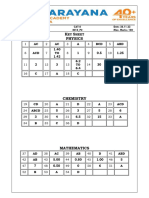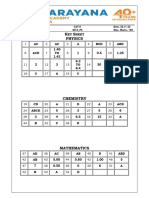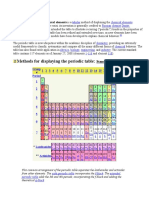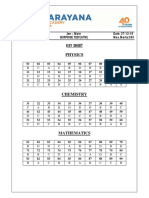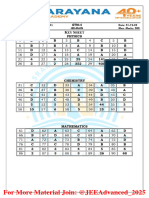Attempt Any Four (4) Questions: April/May 2008
Attempt Any Four (4) Questions: April/May 2008
Uploaded by
Anthony BasantaCopyright:
Available Formats
Attempt Any Four (4) Questions: April/May 2008
Attempt Any Four (4) Questions: April/May 2008
Uploaded by
Anthony BasantaOriginal Title
Copyright
Available Formats
Share this document
Did you find this document useful?
Is this content inappropriate?
Copyright:
Available Formats
Attempt Any Four (4) Questions: April/May 2008
Attempt Any Four (4) Questions: April/May 2008
Uploaded by
Anthony BasantaCopyright:
Available Formats
1
THE UNIVERSITY OF THE WEST INDIES
ST. AUGUSTINE
EXAMINATIONS OF APRIL/MAY 2008
Code and Name of Course: CHEM 3167 (C30A) – ADVANCED INORGANIC CHEMISTRY
Date and Time: Duration: Two (2) hours
INSTRUCTIONS TO CANDIDATES: This paper has Five (5) pages and Six (6) questions
ATTEMPT ANY FOUR (4) QUESTIONS
TOTAL VALUE OF PAPER = 100 MARKS
The use of non-programmable calculators is permitted.
TRACER CHARTS AND CHARACTER TABLES ARE PROVIDED
PERIODIC TABLE OF THE ELEMENTS
1 2
H He
3 4 5 6 7 8 9 10
Li Be B C N O F Ne
11 12 13 14 15 16 17 18
Na Mg Al Si P S Cl Ar
19 20 21 22 23 24 25 26 27 28 29 30 31 32 33 34 35 36
K Ca Sc Ti V Cr Mn Fe Co Ni Cu Zn Ga Ge As Se Br Kr
37 38 39 40 41 42 43 44 45 46 47 48 49 50 51 52 53 54
Rb Sr Y Zr Nb Mo Tc Ru Rh Pd Ag Cd In Sn Sb Te I Xe
55 56 57 72 73 74 75 76 77 78 79 80 81 82 83 84 85 86
Cs Ba La Hf Ta W Re Os Ir Pt Au Hg Tl Pb Bi Po At Rn
87 88
Fr Ra
PLEASE TURN TO THE NEXT PAGE
© The University of the West Indies Course Code C30A 2007/2008/…….
___________________________________________________________________________________________________________
DO NOT WRITE OR TYPE ON THE BACK OF THIS SHEET: USE ONE SIDE ONLY
INSTRUCTIONS: Each page must be signed by the Examiners and where applicable, the University Examiner and/or
the External Examiner. Where the examination does not require a University Examiner, the form must be signed by the First
and Second Examiners. Completed forms should be handed to the Assistant Registrar (Examinations). The EXTERNAL
EXAMINER is requested to sign the question paper and return it with comments, it any, (on a separate sheet), to the Assistant
Registrar (Examinations).
……………………………………. ……………………………………..
First Examiner University Examiner
…………………………………… …………………………………….
Second Examiner External Examiner (where applicable)
Date: 20…/…../….. Date: 20…../……/……
Page 2
1. The water molecule (H2O) belongs to the C2v symmetry point group.
(a) Identify the valence orbitals on the central O atom in the H2O molecule. (3 marks)
(b) Assign the valence orbitals you identified in (a) to symmetry species explaining how you
made your assignments. (5 marks)
(c) Deduce the allowed Terminal Atom Symmetry Orbitals (TASOs) for the peripheral H
atoms stating any rules you used. (4 marks)
(d) Draw a labeled Molecular Orbital Energy Level diagram for the H2O molecule. (8 marks)
(e) Deduce:
(i) the total number of valence electrons in the H2O molecule and fill them into the
diagram you drew in (d). (3 marks)
(ii) the O⎯H bond order. (2 marks)
2. The BF3 molecule belongs to the D3h symmetry point group.
(a) Identify the valence orbitals on the central B atom in the BF3 molecule. (3 marks)
(b) Using the character tables provided, assign as many of the valence orbitals on the B atom
as you can to symmetry species. (2 marks)
(c) Now assign any remaining valence orbitals on the B atom to symmetry species explaining
how you made your assignments. (4 marks)
(d) Deduce the allowed Terminal Atom Symmetry Orbitals (TASOs) for the peripheral
F atoms. (5 marks)
(e) Sketch the allowed 2pz and 2py TASOs for the peripheral F atoms. (6 marks)
PLEASE TURN TO THE NEXT PAGE
© The University of the West Indies Course Code C30A 2007/2008/…….
___________________________________________________________________________________________________________
DO NOT WRITE OR TYPE ON THE BACK OF THIS SHEET: USE ONE SIDE ONLY
INSTRUCTIONS: Each page must be signed by the Examiners and where applicable, the University Examiner and/or
the External Examiner. Where the examination does not require a University Examiner, the form must be signed by the First
and Second Examiners. Completed forms should be handed to the Assistant Registrar (Examinations). The EXTERNAL
EXAMINER is requested to sign the question paper and return it with comments, it any, (on a separate sheet), to the Assistant
Registrar (Examinations).
……………………………………. ……………………………………..
First Examiner University Examiner
…………………………………… …………………………………….
Second Examiner External Examiner (where applicable)
Date: 20…/…../….. Date: 20…../……/……
Page 3
Question 2 (continued)
(f) The following is a partial Molecular Orbital Energy Level Diagram for the BF3 molecule
A1'*
E'*
2px, 2py
2px
A2', E', A2", E", A2"
2pz 2py
2pz
E
2s
E'
A1'
E' 2s TASOs
A 1'
B F TASOs
(i) Determine the total number of valence electrons in the molecule. (2 marks)
(ii) Sketch a representation of this diagram in your answer booklet and fill these electrons
into your diagram. (3 marks)
3. (a) Draw the structure of the complex cation [Fe(diars)2Cl2]+ in the trans-dichloro configuration
[diars = o-phenylene-bis-(dimethylarsine)]. (5 marks)
(b) Use an energy level diagram to show the expected electronic configuration of iron in octahedral
[Fe(diars)2Cl2]+. (5 marks)
PLEASE TURN TO THE NEXT PAGE
© The University of the West Indies Course Code C30A 2007/2008/…….
___________________________________________________________________________________________________________
DO NOT WRITE OR TYPE ON THE BACK OF THIS SHEET: USE ONE SIDE ONLY
INSTRUCTIONS: Each page must be signed by the Examiners and where applicable, the University Examiner and/or
the External Examiner. Where the examination does not require a University Examiner, the form must be signed by the First
and Second Examiners. Completed forms should be handed to the Assistant Registrar (Examinations). The EXTERNAL
EXAMINER is requested to sign the question paper and return it with comments, it any, (on a separate sheet), to the Assistant
Registrar (Examinations).
……………………………………. ……………………………………..
First Examiner University Examiner
…………………………………… …………………………………….
Second Examiner External Examiner (where applicable)
Date: 20…/…../….. Date: 20…../……/……
Page 4
Question 3 (continued)
(c) Detailed structural analysis of [Fe(diars)2Cl2]+ reveals a tetragonally distorted coordination
mode. How are the energy levels and electronic spin of iron likely to be different?
(8 marks)
Would you expect the complex cation to be stable in strong acid if the iron is oxidized to
a tetravalent state? Explain. (7 marks)
4. (a) In processing iron, what is the Bessemer conversion? (5 marks)
(b) Briefly describe the properties of the transition elements which account for their widespread
use as catalysts (10 marks)
(c) In the presence of hydrogen gas, a combination of Ni[P(OEt)3]4 and H2SO4 will effect
isomerization of alkenes. Show the steps leading to the rearrangement of the double bond.
(10 marks)
5. (a) The allyl ligand, C3H5, can attach to a transition metal through one carbon atom (η1) or
through all three carbon atoms (η3).
(i) Assuming that both complexes obey the 18-electron rule, deduce the values of x and y
in [Fe(η1-C3H5)(η5-C5H5)(CO)X] and [Co(η3-C3H5)(CO)Y]. Show your reasoning.
(8 marks)
(ii) Describe how spectroscopic methods could be used to determine whether an allyl
ligand was bonded η1 or η3 to a metal. (5 marks)
(iii) The η3-allyl complex [(η3-MeCHCHCH2)Mn(CO)4] can exist in 2 isomeric forms.
Use a diagram to explain why. (5 marks)
PLEASE TURN TO THE NEXT PAGE
© The University of the West Indies Course Code C30A 2007/2008/…….
___________________________________________________________________________________________________________
DO NOT WRITE OR TYPE ON THE BACK OF THIS SHEET: USE ONE SIDE ONLY
INSTRUCTIONS: Each page must be signed by the Examiners and where applicable, the University Examiner and/or
the External Examiner. Where the examination does not require a University Examiner, the form must be signed by the First
and Second Examiners. Completed forms should be handed to the Assistant Registrar (Examinations). The EXTERNAL
EXAMINER is requested to sign the question paper and return it with comments, it any, (on a separate sheet), to the Assistant
Registrar (Examinations).
……………………………………. ……………………………………..
First Examiner University Examiner
…………………………………… …………………………………….
Second Examiner External Examiner (where applicable)
Date: 20…/…../….. Date: 20…../……/……
Page 5
Question 5 (continued)
(b) The compounds Mo(C6H6)2 and Ru(C6H6)2 each contain two benzene rings coordinated
to a central metal atom. Explain why the room temperature proton decoupled 13C NMR
spectrum of the Mo complex shows a single peak at 75.4 ppm but that of the Ru complex
shows four peaks at 47.2, 68.7, 72.1 and 130.8 ppm in the approximate ratio 2:2:6:2.
(7 marks)
6. For each of the following mixtures of reactants, give (i) a plausible chemical equation and
(ii) the structure for the organometallic product, and (iii) a general reason for the course of the
reaction:
(a) Ru3(CO)11(PMe3) and 2 moles of PMe3;
(b) Phenyllithium and Mo(CO)6;
(c) (OC)5Cr=CPh(OMe) and NHEt2;
(d) MeMn(CO)5 and 1 mole of PMe3;
(e) (η6-C6H5Cl)Cr(CO)3 and NaOMe. (5 x 5 marks)
END OF EXAMINATION PAPER
© The University of the West Indies Course Code C30A 2007/2008/…….
___________________________________________________________________________________________________________
DO NOT WRITE OR TYPE ON THE BACK OF THIS SHEET: USE ONE SIDE ONLY
INSTRUCTIONS: Each page must be signed by the Examiners and where applicable, the University Examiner and/or
the External Examiner. Where the examination does not require a University Examiner, the form must be signed by the First
and Second Examiners. Completed forms should be handed to the Assistant Registrar (Examinations). The EXTERNAL
EXAMINER is requested to sign the question paper and return it with comments, it any, (on a separate sheet), to the Assistant
Registrar (Examinations).
……………………………………. ……………………………………..
First Examiner University Examiner
…………………………………… …………………………………….
Second Examiner External Examiner (where applicable)
Date: 20…/…../….. Date: 20…../……/……
You might also like
- Material Science and Engineering V Raghavan PDF69% (32)Material Science and Engineering V Raghavan PDF461 pages
- International Maths Olympiad - Class 10 (With CD): Theories with examples, MCQs & solutions, Previous questions, Model test papersFrom EverandInternational Maths Olympiad - Class 10 (With CD): Theories with examples, MCQs & solutions, Previous questions, Model test papers4.5/5 (4)
- Ultimate IoT Implementation Guide For Businesses100% (1)Ultimate IoT Implementation Guide For Businesses36 pages
- 06-05-2023 SR - Super60 (Incoming) STERLING BT Jee-Main WTM-30 Key & Sol'sNo ratings yet06-05-2023 SR - Super60 (Incoming) STERLING BT Jee-Main WTM-30 Key & Sol's20 pages
- 23-06-24 - SR - Iit - Star Co-Sc (Model-A&b) - Jee Adv - 2020 (P-I) - Wat-51 - Key & SolNo ratings yet23-06-24 - SR - Iit - Star Co-Sc (Model-A&b) - Jee Adv - 2020 (P-I) - Wat-51 - Key & Sol12 pages
- 17-08-2024 - SR - Super60 - NUCLEUS&STERLING-BT - Jee-Main - RPTM-05&06 - KEY & Sol'SNo ratings yet17-08-2024 - SR - Super60 - NUCLEUS&STERLING-BT - Jee-Main - RPTM-05&06 - KEY & Sol'S16 pages
- 4th Olympiad of Metropolises Chemistry: September 4, 2019 Moscow, RussiaNo ratings yet4th Olympiad of Metropolises Chemistry: September 4, 2019 Moscow, Russia23 pages
- 28-11-22 JR - Iit Star Co-Sc Model-A Jee Adv 2018 P-II Cat-8 Key & Sol FNo ratings yet28-11-22 JR - Iit Star Co-Sc Model-A Jee Adv 2018 P-II Cat-8 Key & Sol F11 pages
- 28-11-22 - JR - Iit - Star Co-Sc - Model-A - Jee Adv - 2018 - P-Ii - Cat-8 - Key & Sol - FNo ratings yet28-11-22 - JR - Iit - Star Co-Sc - Model-A - Jee Adv - 2018 - P-Ii - Cat-8 - Key & Sol - F11 pages
- 29-06-2024 - Sr. C-120 - Jee-Mains - WTM-36 - Key & Sol'sNo ratings yet29-06-2024 - Sr. C-120 - Jee-Mains - WTM-36 - Key & Sol's18 pages
- Sri Chaitanya IIT Academy., India.: Key SheetNo ratings yetSri Chaitanya IIT Academy., India.: Key Sheet17 pages
- 18.04.24 - Osr - Star Co-Sc - Jee-Adv - 2021 - P2 - Gta-6 (P2) - KNo ratings yet18.04.24 - Osr - Star Co-Sc - Jee-Adv - 2021 - P2 - Gta-6 (P2) - K14 pages
- Sri Chaitanya IIT Academy., India: ChemistryNo ratings yetSri Chaitanya IIT Academy., India: Chemistry16 pages
- 26_10_24_Sr_Elite,Target_&_Star_Jee_Mains_RPTM_09_Key_&_Sol's_KNo ratings yet26_10_24_Sr_Elite,Target_&_Star_Jee_Mains_RPTM_09_Key_&_Sol's_K21 pages
- Sri Chaitanya IIT Academy., India: ChemistryNo ratings yetSri Chaitanya IIT Academy., India: Chemistry18 pages
- XI N.M. JEE ADV. PAPER - 2 MAJOR TEST - 4 KEY & SOL. (23-12-2024)No ratings yetXI N.M. JEE ADV. PAPER - 2 MAJOR TEST - 4 KEY & SOL. (23-12-2024)20 pages
- 09-12-2023 - SR - Super60 - NUCLEUS & STERLING - BT - Jee-Main-RPTM-18 - KEY & Sol'SNo ratings yet09-12-2023 - SR - Super60 - NUCLEUS & STERLING - BT - Jee-Main-RPTM-18 - KEY & Sol'S11 pages
- 06 01 2024 JR Super60 STERLING BT Jee Main CTM 17 Key & Sol'sNo ratings yet06 01 2024 JR Super60 STERLING BT Jee Main CTM 17 Key & Sol's22 pages
- Grade 11 Science Practice Test: Nebraska Department of Education 2012No ratings yetGrade 11 Science Practice Test: Nebraska Department of Education 201213 pages
- STAAR Science Tutorial 10-Periodic TableNo ratings yetSTAAR Science Tutorial 10-Periodic Table4 pages
- 30 07 23 SR Iit Star Co Scmodel A Jee Adv 2019P I Wat 49 Key&solNo ratings yet30 07 23 SR Iit Star Co Scmodel A Jee Adv 2019P I Wat 49 Key&sol12 pages
- 05-02-22_JR.IIT_STAR CO-SC(MODEL-B)_JEE ADV_2017(P-I)_WAT-38_KEY _ SOL (1)No ratings yet05-02-22_JR.IIT_STAR CO-SC(MODEL-B)_JEE ADV_2017(P-I)_WAT-38_KEY _ SOL (1)5 pages
- 02-11-24 - SR - Elite, Target & Star - Jee Mains - RPTM-10 - Key & Sol's - TNo ratings yet02-11-24 - SR - Elite, Target & Star - Jee Mains - RPTM-10 - Key & Sol's - T21 pages
- Q1 Q2 Q3 Q4 Q5 Q6 Q7 Q8: Write The Best Fit Answer of The Following Questions in This TableNo ratings yetQ1 Q2 Q3 Q4 Q5 Q6 Q7 Q8: Write The Best Fit Answer of The Following Questions in This Table5 pages
- Chemistry Standard Level Paper 1: Instructions To CandidatesNo ratings yetChemistry Standard Level Paper 1: Instructions To Candidates11 pages
- 28.11.22 - SR - STAR CO-SC (MODEL-A) - Jee - Adv - 2022 - P2 - CTA-5 - KEY & SOLNo ratings yet28.11.22 - SR - STAR CO-SC (MODEL-A) - Jee - Adv - 2022 - P2 - CTA-5 - KEY & SOL14 pages
- 30-06-24 - SR - IIT - STAR CO-SC (MODEL-A) - Jee-Main - CTM-13 - KEY & SOLNo ratings yet30-06-24 - SR - IIT - STAR CO-SC (MODEL-A) - Jee-Main - CTM-13 - KEY & SOL21 pages
- Methods For Displaying The Periodic TableNo ratings yetMethods For Displaying The Periodic Table7 pages
- 27-12-18 SR - Iit-Iz-Co Spark Jee-Main Surprise Test (GTM) Key & SolsNo ratings yet27-12-18 SR - Iit-Iz-Co Spark Jee-Main Surprise Test (GTM) Key & Sols13 pages
- 23-07-22 - Sr.C-IPL (Incoming) - JEE-Main-WTM-09 - KEY & Sol'SNo ratings yet23-07-22 - Sr.C-IPL (Incoming) - JEE-Main-WTM-09 - KEY & Sol'S12 pages
- 22_01_2025_SR_STAR_CO_SCMODEL_A&_APEX_Jee_Main_GTM_23_KEY&SONo ratings yet22_01_2025_SR_STAR_CO_SCMODEL_A&_APEX_Jee_Main_GTM_23_KEY&SO15 pages
- Xi Iit - Wta-29 - (2020-P1) - Key & Sols - 01-05-2022No ratings yetXi Iit - Wta-29 - (2020-P1) - Key & Sols - 01-05-202211 pages
- Sri Chaitanya IIT Academy., India: ChemistryNo ratings yetSri Chaitanya IIT Academy., India: Chemistry22 pages
- 10-12-23 JR - Iit Star Co-Sc (Model-A) Jee Adv 2021 (P-I) Wat-31 Key & SolNo ratings yet10-12-23 JR - Iit Star Co-Sc (Model-A) Jee Adv 2021 (P-I) Wat-31 Key & Sol12 pages
- SR Iit Star Model - A&apex - Jee Main Ptm-14 (Pt-14-Syllabus) Mock Test Key (06!11!24)No ratings yetSR Iit Star Model - A&apex - Jee Main Ptm-14 (Pt-14-Syllabus) Mock Test Key (06!11!24)16 pages
- 11-08-24 - JR - Iit - Star Co-Sc (Model-B) - Jee Adv - 2019 (P-I) - Wat-17 - Key & SolNo ratings yet11-08-24 - JR - Iit - Star Co-Sc (Model-B) - Jee Adv - 2019 (P-I) - Wat-17 - Key & Sol13 pages
- 01-12-19 - Sri Chaitanya-Sr - Chaina-I - L-I & II - Jee-Adv - 2018-P2 - CTA-6 - Key & Sol'sNo ratings yet01-12-19 - Sri Chaitanya-Sr - Chaina-I - L-I & II - Jee-Adv - 2018-P2 - CTA-6 - Key & Sol's20 pages
- 31 12 23 SR Star Co Scmodel A, B&C Jee Main GTM 4 Key&SolNo ratings yet31 12 23 SR Star Co Scmodel A, B&C Jee Main GTM 4 Key&Sol16 pages
- SR - ICON All - EAMCET - Practice - GT-4 - Key & Sol'sNo ratings yetSR - ICON All - EAMCET - Practice - GT-4 - Key & Sol's15 pages
- Infrared Spectroscopy of Triatomics for Space ObservationFrom EverandInfrared Spectroscopy of Triatomics for Space ObservationNo ratings yet
- Education Act: Laws of Trinidad and TobagoNo ratings yetEducation Act: Laws of Trinidad and Tobago126 pages
- Atomic Structure Timeline: 400 BC, Scientist: Democritus (Greek Philosopher)No ratings yetAtomic Structure Timeline: 400 BC, Scientist: Democritus (Greek Philosopher)13 pages
- Post SEA Spanish Exploratory: Ministry of EducationNo ratings yetPost SEA Spanish Exploratory: Ministry of Education8 pages
- MORALS AND VALUES EDUCATION Prim SummaryNo ratings yetMORALS AND VALUES EDUCATION Prim Summary2 pages
- Ministry of Education Summary of Primary Social Studies CurriculumNo ratings yetMinistry of Education Summary of Primary Social Studies Curriculum2 pages
- Primary Spanish Syllabus: Ministry of EducationNo ratings yetPrimary Spanish Syllabus: Ministry of Education66 pages
- Months Sales Expenses Profits Jan 150 125 25 Feb 175 150 25 Mar 225 210 14 Totals 550 485 64 Apr Proj 187.5 167.5 19.5No ratings yetMonths Sales Expenses Profits Jan 150 125 25 Feb 175 150 25 Mar 225 210 14 Totals 550 485 64 Apr Proj 187.5 167.5 19.52 pages
- Programmable Unijunction Transistor: Experiment 5No ratings yetProgrammable Unijunction Transistor: Experiment 58 pages
- Contaminations Test of Food Processing Equipment and ContainersNo ratings yetContaminations Test of Food Processing Equipment and Containers8 pages
- Lecture 11 - MDPE - Design of Support - Leg & Skirt Support100% (1)Lecture 11 - MDPE - Design of Support - Leg & Skirt Support47 pages
- Ground Handling and Servicing 13-21: Start EnginesNo ratings yetGround Handling and Servicing 13-21: Start Engines11 pages
- Study Report On Implications of UnbondednessNo ratings yetStudy Report On Implications of Unbondedness19 pages
- Welcome To Unity OE v4.1 - Scalability and Performance.No ratings yetWelcome To Unity OE v4.1 - Scalability and Performance.47 pages
- What Is Digital Image? Intensity Gray LevelNo ratings yetWhat Is Digital Image? Intensity Gray Level19 pages
- A B C D A B C D A B C D: Foundation Plan 1 Second Floor Framing Plan 2 Roof Beam Framing Plan 30% (1)A B C D A B C D A B C D: Foundation Plan 1 Second Floor Framing Plan 2 Roof Beam Framing Plan 31 page
- Catalog Pumps - May 2013 - PDF.334121525No ratings yetCatalog Pumps - May 2013 - PDF.33412152539 pages
- International Maths Olympiad - Class 10 (With CD): Theories with examples, MCQs & solutions, Previous questions, Model test papersFrom EverandInternational Maths Olympiad - Class 10 (With CD): Theories with examples, MCQs & solutions, Previous questions, Model test papers
- 06-05-2023 SR - Super60 (Incoming) STERLING BT Jee-Main WTM-30 Key & Sol's06-05-2023 SR - Super60 (Incoming) STERLING BT Jee-Main WTM-30 Key & Sol's
- 23-06-24 - SR - Iit - Star Co-Sc (Model-A&b) - Jee Adv - 2020 (P-I) - Wat-51 - Key & Sol23-06-24 - SR - Iit - Star Co-Sc (Model-A&b) - Jee Adv - 2020 (P-I) - Wat-51 - Key & Sol
- 17-08-2024 - SR - Super60 - NUCLEUS&STERLING-BT - Jee-Main - RPTM-05&06 - KEY & Sol'S17-08-2024 - SR - Super60 - NUCLEUS&STERLING-BT - Jee-Main - RPTM-05&06 - KEY & Sol'S
- 4th Olympiad of Metropolises Chemistry: September 4, 2019 Moscow, Russia4th Olympiad of Metropolises Chemistry: September 4, 2019 Moscow, Russia
- 28-11-22 JR - Iit Star Co-Sc Model-A Jee Adv 2018 P-II Cat-8 Key & Sol F28-11-22 JR - Iit Star Co-Sc Model-A Jee Adv 2018 P-II Cat-8 Key & Sol F
- 28-11-22 - JR - Iit - Star Co-Sc - Model-A - Jee Adv - 2018 - P-Ii - Cat-8 - Key & Sol - F28-11-22 - JR - Iit - Star Co-Sc - Model-A - Jee Adv - 2018 - P-Ii - Cat-8 - Key & Sol - F
- 29-06-2024 - Sr. C-120 - Jee-Mains - WTM-36 - Key & Sol's29-06-2024 - Sr. C-120 - Jee-Mains - WTM-36 - Key & Sol's
- 18.04.24 - Osr - Star Co-Sc - Jee-Adv - 2021 - P2 - Gta-6 (P2) - K18.04.24 - Osr - Star Co-Sc - Jee-Adv - 2021 - P2 - Gta-6 (P2) - K
- 26_10_24_Sr_Elite,Target_&_Star_Jee_Mains_RPTM_09_Key_&_Sol's_K26_10_24_Sr_Elite,Target_&_Star_Jee_Mains_RPTM_09_Key_&_Sol's_K
- XI N.M. JEE ADV. PAPER - 2 MAJOR TEST - 4 KEY & SOL. (23-12-2024)XI N.M. JEE ADV. PAPER - 2 MAJOR TEST - 4 KEY & SOL. (23-12-2024)
- 09-12-2023 - SR - Super60 - NUCLEUS & STERLING - BT - Jee-Main-RPTM-18 - KEY & Sol'S09-12-2023 - SR - Super60 - NUCLEUS & STERLING - BT - Jee-Main-RPTM-18 - KEY & Sol'S
- 06 01 2024 JR Super60 STERLING BT Jee Main CTM 17 Key & Sol's06 01 2024 JR Super60 STERLING BT Jee Main CTM 17 Key & Sol's
- Grade 11 Science Practice Test: Nebraska Department of Education 2012Grade 11 Science Practice Test: Nebraska Department of Education 2012
- 30 07 23 SR Iit Star Co Scmodel A Jee Adv 2019P I Wat 49 Key&sol30 07 23 SR Iit Star Co Scmodel A Jee Adv 2019P I Wat 49 Key&sol
- 05-02-22_JR.IIT_STAR CO-SC(MODEL-B)_JEE ADV_2017(P-I)_WAT-38_KEY _ SOL (1)05-02-22_JR.IIT_STAR CO-SC(MODEL-B)_JEE ADV_2017(P-I)_WAT-38_KEY _ SOL (1)
- 02-11-24 - SR - Elite, Target & Star - Jee Mains - RPTM-10 - Key & Sol's - T02-11-24 - SR - Elite, Target & Star - Jee Mains - RPTM-10 - Key & Sol's - T
- Q1 Q2 Q3 Q4 Q5 Q6 Q7 Q8: Write The Best Fit Answer of The Following Questions in This TableQ1 Q2 Q3 Q4 Q5 Q6 Q7 Q8: Write The Best Fit Answer of The Following Questions in This Table
- Chemistry Standard Level Paper 1: Instructions To CandidatesChemistry Standard Level Paper 1: Instructions To Candidates
- 28.11.22 - SR - STAR CO-SC (MODEL-A) - Jee - Adv - 2022 - P2 - CTA-5 - KEY & SOL28.11.22 - SR - STAR CO-SC (MODEL-A) - Jee - Adv - 2022 - P2 - CTA-5 - KEY & SOL
- 30-06-24 - SR - IIT - STAR CO-SC (MODEL-A) - Jee-Main - CTM-13 - KEY & SOL30-06-24 - SR - IIT - STAR CO-SC (MODEL-A) - Jee-Main - CTM-13 - KEY & SOL
- 27-12-18 SR - Iit-Iz-Co Spark Jee-Main Surprise Test (GTM) Key & Sols27-12-18 SR - Iit-Iz-Co Spark Jee-Main Surprise Test (GTM) Key & Sols
- 23-07-22 - Sr.C-IPL (Incoming) - JEE-Main-WTM-09 - KEY & Sol'S23-07-22 - Sr.C-IPL (Incoming) - JEE-Main-WTM-09 - KEY & Sol'S
- 22_01_2025_SR_STAR_CO_SCMODEL_A&_APEX_Jee_Main_GTM_23_KEY&SO22_01_2025_SR_STAR_CO_SCMODEL_A&_APEX_Jee_Main_GTM_23_KEY&SO
- Xi Iit - Wta-29 - (2020-P1) - Key & Sols - 01-05-2022Xi Iit - Wta-29 - (2020-P1) - Key & Sols - 01-05-2022
- 10-12-23 JR - Iit Star Co-Sc (Model-A) Jee Adv 2021 (P-I) Wat-31 Key & Sol10-12-23 JR - Iit Star Co-Sc (Model-A) Jee Adv 2021 (P-I) Wat-31 Key & Sol
- SR Iit Star Model - A&apex - Jee Main Ptm-14 (Pt-14-Syllabus) Mock Test Key (06!11!24)SR Iit Star Model - A&apex - Jee Main Ptm-14 (Pt-14-Syllabus) Mock Test Key (06!11!24)
- 11-08-24 - JR - Iit - Star Co-Sc (Model-B) - Jee Adv - 2019 (P-I) - Wat-17 - Key & Sol11-08-24 - JR - Iit - Star Co-Sc (Model-B) - Jee Adv - 2019 (P-I) - Wat-17 - Key & Sol
- 01-12-19 - Sri Chaitanya-Sr - Chaina-I - L-I & II - Jee-Adv - 2018-P2 - CTA-6 - Key & Sol's01-12-19 - Sri Chaitanya-Sr - Chaina-I - L-I & II - Jee-Adv - 2018-P2 - CTA-6 - Key & Sol's
- 31 12 23 SR Star Co Scmodel A, B&C Jee Main GTM 4 Key&Sol31 12 23 SR Star Co Scmodel A, B&C Jee Main GTM 4 Key&Sol
- SR - ICON All - EAMCET - Practice - GT-4 - Key & Sol'sSR - ICON All - EAMCET - Practice - GT-4 - Key & Sol's
- Infrared Spectroscopy of Triatomics for Space ObservationFrom EverandInfrared Spectroscopy of Triatomics for Space Observation
- Atomic Structure Timeline: 400 BC, Scientist: Democritus (Greek Philosopher)Atomic Structure Timeline: 400 BC, Scientist: Democritus (Greek Philosopher)
- Post SEA Spanish Exploratory: Ministry of EducationPost SEA Spanish Exploratory: Ministry of Education
- Ministry of Education Summary of Primary Social Studies CurriculumMinistry of Education Summary of Primary Social Studies Curriculum
- Months Sales Expenses Profits Jan 150 125 25 Feb 175 150 25 Mar 225 210 14 Totals 550 485 64 Apr Proj 187.5 167.5 19.5Months Sales Expenses Profits Jan 150 125 25 Feb 175 150 25 Mar 225 210 14 Totals 550 485 64 Apr Proj 187.5 167.5 19.5
- Contaminations Test of Food Processing Equipment and ContainersContaminations Test of Food Processing Equipment and Containers
- Lecture 11 - MDPE - Design of Support - Leg & Skirt SupportLecture 11 - MDPE - Design of Support - Leg & Skirt Support
- Ground Handling and Servicing 13-21: Start EnginesGround Handling and Servicing 13-21: Start Engines
- Welcome To Unity OE v4.1 - Scalability and Performance.Welcome To Unity OE v4.1 - Scalability and Performance.
- A B C D A B C D A B C D: Foundation Plan 1 Second Floor Framing Plan 2 Roof Beam Framing Plan 3A B C D A B C D A B C D: Foundation Plan 1 Second Floor Framing Plan 2 Roof Beam Framing Plan 3

















